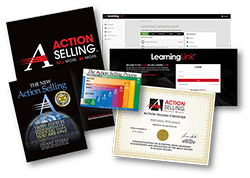
A WORD FROM DUANE SPARKS
Dear Sales Executive:
The Sales Board’s data shows that 90% of all salespeople are ineffective at dealing with stalls and objections. If your company is typical, that means nine out of 10 of your reps are leaving money on the table.
It’s an old problem, and sales training hasn’t helped much. I believe that’s because salespeople have been learning the wrong methods. It’s time to replace old ideas with better ones.
When it comes to stalls and objections, I believe that current sales training programs fail for three major reasons. In this edition of eCoach, let’s talk about the first one.
If you have a question about how to deal more effectively with stalls and objections, click on “Ask The eCoach“.
We are committed to your professional success.
Duane Sparks Author of Action Selling ®
Stalls Vs. Objections: No, They Don’t Have the Same Solution
I believe there are three main reasons why 90% of salespeople remain unable to cope effectively with stalls and objections, despite all the training that companies throw at the problem.
The first reason is that sales training programs address stalls and objections as if they were the same. Therefore, nobody tells you that it is crucial to distinguish between the two because they are not the same, and they require different responses. Unless you know that, you are going to fail.
Here is the essential difference:
An objection arises when there is a specific reason why your prospect does not intend to buy from you yet. The reason always relates to one of the five key buying decisions that every customer makes in the course of every major sale: Salesperson, Company, Product/Service, Price, or Time-to-Buy. An objecting customer might challenge you on your price. Or they might be more sold on a competitor’s company or salesperson. Or they might question the need to own the product you are offering.
While an objection ties to a specific buying decision, a stalling customer does not have a specific reason for declining to make a commitment. Stalls may come in a thousand forms, but they all mean the same thing: “I’m not quite sold yet; I need you to sell me some more.”
Here are examples of the two different animals:
Is it a Stall or an Objection?
Examples of Stalls:
“I want to think it over. Call me next week?”
“We’re tied up with budgets right now.”
“I’m sorry, I haven’t checked the references yet.”
“Send me a proposal and a brochure.”
“Let me run it up the flagpole with my team.”
Examples of Objections:
Trying to cope with stalls and objections using the same approach is dead wrong. As long as you do that, you will fail to handle either successfully.
Attack stalls and objections with the same approach, and you will fail to handle either successfully.
Challenging a stall pushes the customer to think up reasons why she is hesitating. If she has no specific reason for stalling, your challenge forces her to come up with one. Once she gives you a reason, she will be inclined to defend it. Now you are antagonists—the last thing you want.
Since all stalls mean the same thing (“I’m not sold yet; sell me some more.”), the correct response to a stall is to give customers exactly what they are asking for: Sell them some more. How? See the link to our recent white paper on the topic below.
Handling objections – To repeat, objections always relate to one or more of the customer’s Five Buying Decisions (Salesperson, Company, Product/Service, Price, or Time-to-Buy). When a salesperson Asks for Commitment (in what Action Selling ® calls Act 7) and the customer presents an objection, a little voice should whisper into the salesperson’s ear: “This prospect isn’t sold on one or more of the Five Buying Decisions. That means I didn’t ask all of the right questions earlier in the sales call. I need to go back to Act 3 and Ask the Best Questions.”
When objections occur, you must back up to Act 3 and gather more information by asking better questions. Then present a solution to the objection and ask again for a commitment. In other words, to respond to an objection you’ll simply follow Act 3 through Act 7 of Action Selling ®.
Treat stalls and objections as the very different things they are, and you will have far more success dealing with both.
In the next edition of eCoach, we will look at the second of three main reasons why most sales training fails to eliminate difficulties with stalls and objections:
Download our new White Paper that describes the best ways to handle stalls and objections in more detail. Objection! Is This the Salesperson’s Weakest Skill?
Action Selling ® in Action
Here are some comments from Bergan partner Lee Roberts:
“We always start customer meetings now with the same question: What’s changed since the last time we spoke? In many cases, if there is an objection it surfaces right away. The same applies to stalls.
“If we get a stall or objection,” Roberts continues, “it usually arises because a competitor has told the client that they don’t need a certain product we offer. In reality, the competitor wants to create billable CPA hours rather than provide automation that will avoid billable hours. When this happens, we use Action Selling ® methodology to neutralize it. We go to Act 3 and ‘Ask the Best Questions’ to help us and the client understand the consequences of not solving the problem. We use leverage questions to turn up the heat on the issue so the client is even more motivated to implement our recommendation.”
For information about how to make sales training pay huge dividends, contact Action Selling ® at (800) 232-3485.
Want a more in-depth look at the best ways to handle stalls and objections? Download our new White Paper. Objection! Is This the Salesperson’s Weakest Skill?
Recent eCoaches
Don’t Look Now, But Your Sales Culture Gap is Growing
Close Your Culture Gap! Align Sales and Service
Why 64% of Salespeople Don’t Close
Stalls Vs. Objections: No, They Don’t Have the Same Solution
No Detours! Why Must You Leave the Sales Path Just to Handle an Objection?
I Object! (To the Way You Define Objections)
How to Train Your Way Out of a Sales Slump
It’s Not What You Sell, It’s How You Sell
How Do You Know If Your Sales Force Is Good?
“One Call” Close Not Dead Yet?
TQM for Sales Leadership? Yes!
Six Critical Processes for Sales Leaders
10 Great Ideas About Sales Leadership
The Three Core Roles of Every Sales Leader
The Nine Acts of Sales Leadership
5 Secrets to Record-Breaking Sales
Sales Training That Actually Works
The Sales Leader’s Toughest Challenge
How Strong is Your Sales Culture?
Want to Create the Best Sales Culture?


ASSESS YOUR SALES SKILLS
Unlock your hidden sales potential today – take our free Selling Skills Assessment.

THE NEW ACTION SELLING
A Quick Read That Will Boost Your Sales — Guaranteed!


